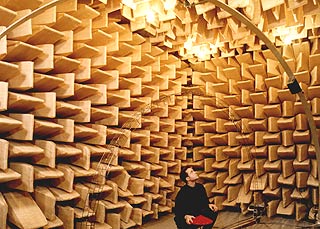.jpg)
The Prandtl-Glauert singularity, the point at which a sudden drop in air pressure occurs, is generally accepted as the cause of the visible condensation cloud that often surrounds an aircraft travelling at transonic speeds, though there remains some debate. It is an example of a mathematical singularity in aerodynamics.
One view of this phenomenon is that it exhibits the effect of compressibility and the so-called N-wave. The N-wave is the time variant pressure profile seen by a static observer as a sonic compression wave passes. The overall three-dimensional shock wave is in the form of a cone with its apex at the supersonic aircraft. This wave follows the aircraft. The pressure profile of the wave is composed of a leading compression component (the initial upward stroke of the "N"), followed by a pressure descent forming a rarefaction of the air (the downward diagonal of the "N"), followed by a return to the normal ambient pressure (the final upward stroke of the "N"). The rarefaction may be thought of as the "rebounding" of the compression due to inertial effects. These condensation clouds, also known as "shock-collars" or "shock eggs," are frequently seen during space-shuttle launches around 25 to 33 seconds after launch when the vehicle passes through the area of maximum dynamic air-pressure (see Max Q). Since heat does not leave the affected air mass, this change of pressure is adiabatic, with an associated change of temperature. In humid air, the drop in temperature in the most rarefied portion of the shock wave (close to the aircraft) can bring the air temperature below its dew point, at which moisture condenses to form a visible cloud of microscopic water droplets. Since the pressure effect of the wave is reduced by its expansion (the same pressure effect is spread over a larger radius), the vapor effect also has a limited radius. Such vapor can also be seen in low pressure regions during high–g subsonic maneuvers in humid conditions.
http://en.wikipedia.org/wiki/Prandtl-Glauert_singularity
One view of this phenomenon is that it exhibits the effect of compressibility and the so-called N-wave. The N-wave is the time variant pressure profile seen by a static observer as a sonic compression wave passes. The overall three-dimensional shock wave is in the form of a cone with its apex at the supersonic aircraft. This wave follows the aircraft. The pressure profile of the wave is composed of a leading compression component (the initial upward stroke of the "N"), followed by a pressure descent forming a rarefaction of the air (the downward diagonal of the "N"), followed by a return to the normal ambient pressure (the final upward stroke of the "N"). The rarefaction may be thought of as the "rebounding" of the compression due to inertial effects. These condensation clouds, also known as "shock-collars" or "shock eggs," are frequently seen during space-shuttle launches around 25 to 33 seconds after launch when the vehicle passes through the area of maximum dynamic air-pressure (see Max Q). Since heat does not leave the affected air mass, this change of pressure is adiabatic, with an associated change of temperature. In humid air, the drop in temperature in the most rarefied portion of the shock wave (close to the aircraft) can bring the air temperature below its dew point, at which moisture condenses to form a visible cloud of microscopic water droplets. Since the pressure effect of the wave is reduced by its expansion (the same pressure effect is spread over a larger radius), the vapor effect also has a limited radius. Such vapor can also be seen in low pressure regions during high–g subsonic maneuvers in humid conditions.
http://en.wikipedia.org/wiki/Prandtl-Glauert_singularity

